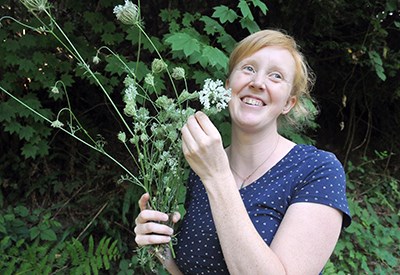The giant hogweed is one plant you don't want to come into contact with and after years of dedicated eradication efforts, Tri-City residents aren't likely to.
Native to Asia, the perennial plant has been mostly eradicated in this area although there are still a handful of spots that city crews are actively managing with some unexpected help from the unusually hot, dry summer.
Coquitlam parks resource technician Shannon Wagner said hogweed reports are down this year, with only one new plant identified, and historic hogweed locations that have seen ongoing control have little to no new plants present.
"One theory could be that the seed bank in the soil didn't have enough water for the plants to germinate this year," because of the low rainfall, Wagner said. "But this doesn't mean that we won't have hogweed next year, as the seeds do stay viable for many years."
Giant hogweed started cropping up in Metro Vancouver in 2006, according to the Invasive Species Council of BC, and its aggressive nature allowed it to spread quickly. The plant can grow to up to six metres high and its large leafy canopy crowds out native plants while the sap causes severe burns; if it gets into a person's eyes the sap can cause permanent blindness.
Hogweed was most pervasive around 2009 and 2010, Wagner said, but a public awareness campaign helped residents identify the plant on their properties or in city parks for eradication.
Port Coquitlam's giant hogweed problem is also nearing eradication, said Todd Gross, manager of parks & services. The city started with 450 plants on 15 sites but vigilant monitoring has ensured the seed bank at these locations has been mostly depleted.
There are now just three sites with active hogweed growth, which will be eradicated this season, and only one new location reported with a single plant that has already been treated.
"We have made great strides over the past 10 years with removing this noxious weed from within our city limits," Gross added. "This has been greatly assisted by the dedication of our homeowners to be a viable part of the city's integrated pest management program."
In Coquitlam, Wagner said there is a lot of public interest around hogweed and far more people are aware of the plant but there is still a lot of false identification, mainly with similar-looking plants such as Devil's Club, Queen Ann's Lace and goutweed (when flowering).
"There's definitely no problem with people reporting a misidentification," Wagner said. "We still encourage people to report [hogweed] if they think they see it."
Anyone looking to get rid of giant hogweed on their property is encouraged to check the WorkSafe BC site first to ensure they're following the proper safety protocols, or to hire a qualified technician.
[email protected]
@spayneTC



